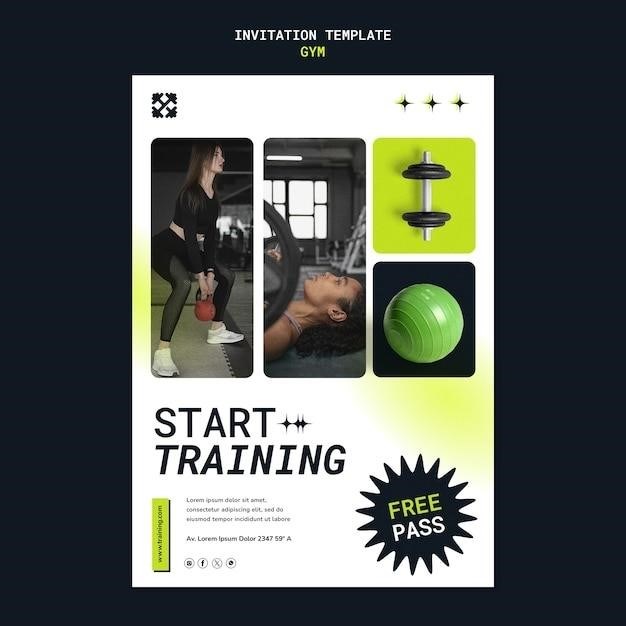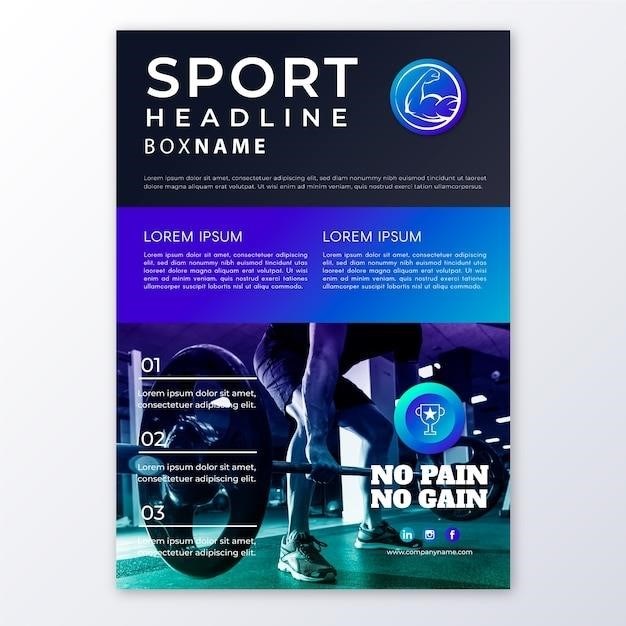Half Ironman Training Program PDFs⁚ A Comprehensive Guide
This guide explores various half Ironman training plan PDFs, offering structured programs for different experience levels. From novice to advanced, find a plan that suits your fitness and time commitment. Learn about periodization, nutrition, and recovery strategies for optimal results.
Introduction⁚ Why Choose a Half Ironman Training Plan?
Embarking on a half Ironman journey requires a structured approach, and a well-designed training plan is paramount. These plans provide a roadmap to success, guiding you through the demanding swim, bike, and run segments. A structured plan ensures progressive overload, preventing injury and maximizing your potential. It helps manage training volume and intensity across different disciplines, ensuring balanced development. Following a plan promotes consistency, crucial for achieving the significant endurance gains necessary for a half Ironman. Various plans cater to different experience levels, from beginner to advanced, ensuring a personalized approach. Ultimately, a structured plan reduces the risk of burnout, keeps you motivated, and increases your chances of finishing strong.

Understanding Half Ironman Distance⁚ Swim, Bike, Run Breakdown

A half Ironman triathlon, also known as an IRONMAN 70.3, presents a significant endurance challenge. The race comprises three distinct disciplines⁚ a 1.9-kilometer (1.2-mile) swim, a 90-kilometer (56-mile) cycling leg, and a 21.1-kilometer (13.1-mile) run. Each segment demands specific training and preparation. The swim requires efficient technique and endurance in open water, often necessitating wetsuit use. The cycling leg involves significant distance, demanding strength, endurance, and bike handling skills on varied terrain. Finally, the run, a half marathon, tests running endurance and requires pacing strategy to avoid exhaustion. Understanding the demands of each stage is crucial when selecting and following a training plan. Successful completion hinges on balanced preparation across all three disciplines.
Training Plan Structures⁚ Novice vs. Intermediate Programs
Half Ironman training plans cater to various experience levels, notably differentiating between novice and intermediate athletes. Novice programs prioritize building a solid base fitness level and gradually increasing training volume and intensity. These plans often span 20 weeks or more, focusing on consistent progress and injury prevention. They typically incorporate lower weekly training hours, emphasizing proper technique and gradual adaptation to the demands of each discipline. In contrast, intermediate plans assume a pre-existing base fitness and aim to enhance performance. These programs are usually shorter, perhaps 12-16 weeks, and involve higher weekly training volumes and more intense workouts. They might incorporate advanced training techniques like interval training and tempo runs to improve speed and endurance. Choosing the right plan is crucial; selecting a plan beyond one’s capabilities could lead to injury or burnout, while an overly easy plan might not yield optimal results.
Finding the Right PDF⁚ Beginner, Intermediate, and Advanced Options
The plethora of available half Ironman training plan PDFs necessitates careful selection based on individual experience and goals. Beginner plans, often 20 weeks long, emphasize gradual progression, building a robust base before increasing intensity. These plans prioritize proper form and injury prevention, featuring manageable weekly training hours. Intermediate plans, typically 12-16 weeks, assume a pre-existing fitness level, focusing on performance enhancement through higher training volume and intensity. Advanced options might be shorter, focusing on peak performance for experienced athletes. Consider factors like weekly time commitment, personal fitness level, and race goals when choosing. Many websites and coaching services offer free or paid plans, each with different structures and focuses. Some plans offer detailed descriptions, while others provide simpler schedules. Look for plans with clear instructions, realistic goals, and a progressive approach to avoid injury and ensure sustainable training.
Key Components of Effective Half Ironman Training Plans⁚ Periodization
Effective half Ironman training plans utilize periodization, a systematic approach that divides training into distinct phases⁚ base building, strength building, and peaking. The base phase focuses on building aerobic capacity and endurance through consistent, moderate-intensity workouts. This establishes a foundation of fitness crucial for handling the demands of longer training sessions. The strength phase incorporates higher intensity intervals and strength training to improve power and speed. This enhances performance in each discipline – swimming, cycling, and running – during the race. The final peaking phase involves a strategic reduction in training volume while maintaining or slightly increasing intensity. This allows the body to recover and fully prepare for the race. Proper periodization prevents overtraining, optimizes performance gains, and minimizes the risk of injury. It ensures that the athlete is at their peak physical condition on race day. Successful periodization requires careful planning, monitoring progress, and adjusting the plan as needed to accommodate individual needs and responses.
Essential Elements⁚ Strength Training and Cross-Training
Incorporating strength training and cross-training is vital for a well-rounded half Ironman training program. Strength training builds muscle strength and endurance, improving power output during swimming, cycling, and running. Focus on compound exercises like squats, deadlifts, and presses to engage multiple muscle groups simultaneously. These exercises enhance overall strength and power, leading to improved performance in each leg of the triathlon. Cross-training activities, such as swimming, cycling, running, and strength training, help prevent overuse injuries. They provide active recovery, allowing specific muscles to rest while maintaining overall fitness levels. Examples include yoga, Pilates, or light cardio activities. These activities improve flexibility and balance, reducing the risk of injury and enhancing overall athleticism. Cross-training also helps break the monotony of repetitive training, improving both physical and mental well-being. A balanced approach to strength training and cross-training enhances overall fitness, reduces injury risk, and maximizes performance in a half Ironman.
Nutrition and Hydration Strategies for Optimal Performance
Proper nutrition and hydration are cornerstones of successful half Ironman training. Fueling your body correctly supports intense workouts and aids recovery. Prioritize complex carbohydrates for sustained energy, lean proteins for muscle repair, and healthy fats for hormone production. Consume a balanced diet throughout the day, emphasizing nutrient-dense foods like fruits, vegetables, and whole grains. Hydration is equally crucial; dehydration significantly impacts performance. Drink plenty of water throughout the day, especially during and after training sessions. Consider electrolyte drinks to replenish minerals lost through sweat, particularly during longer workouts. Experiment with different fueling strategies during training to find what works best for your body. Practice race-day nutrition during long training sessions to simulate real-life conditions. This could involve consuming energy gels, chews, or sports drinks at regular intervals. Pay attention to how your body responds to different foods and hydration strategies, adjusting your plan accordingly. A well-planned nutrition and hydration strategy ensures optimal energy levels, aids recovery, and maximizes your performance on race day.
Sample Training Week⁚ A Glimpse into a Typical Schedule
A typical week in a half Ironman training plan involves a balanced approach to swim, bike, and run training, incorporating rest and cross-training. Monday might start with a shorter, high-intensity swim session, followed by strength training focusing on core and leg muscles. Tuesday could include a longer, endurance-focused cycling session, followed by a light run for active recovery. Wednesday might be a rest day or dedicated to cross-training activities like yoga or swimming. Thursday could mirror Monday’s structure, with a shorter, intense swim followed by strength training. Friday could involve a longer run, building endurance and focusing on a comfortable pace. Saturday might be a long bike ride incorporating hill work and sustained effort. Sunday often includes a long run, possibly incorporating race-pace intervals or tempo runs. The intensity and duration of each workout vary throughout the training plan, gradually increasing as the race approaches. Remember, this is a sample; specific training schedules vary considerably based on individual fitness levels and the overall training plan’s structure. Always prioritize proper rest and recovery to avoid overtraining and maximize performance.
Planning Your Nutrition and Hydration⁚ Fueling Your Training
Proper nutrition and hydration are crucial for successful half Ironman training. Your diet should support intense workouts and recovery. Focus on a balanced intake of carbohydrates for energy, protein for muscle repair, and healthy fats for overall health. During training, consume easily digestible carbohydrates like gels, chews, or sports drinks to maintain energy levels. Experiment with different fueling strategies during long training sessions to determine what works best for your body. Hydration is equally important; drink plenty of water throughout the day, especially before, during, and after workouts; Electrolyte drinks can help replenish minerals lost through sweat. Pay close attention to your body’s signals; adjust your nutrition and hydration plan based on individual needs and responses to training. Consider consulting a registered dietitian or sports nutritionist for personalized guidance on optimizing your fueling strategy for peak performance. Remember, consistent and strategic nutrition is key to successful endurance training.
Importance of Rest and Recovery⁚ Preventing Overtraining
Rest and recovery are paramount in preventing overtraining and maximizing performance in your half Ironman journey. Adequate sleep is crucial; aim for 7-9 hours of quality sleep per night to allow your body to repair and rebuild. Incorporate rest days into your training schedule; these allow muscles to recover and prevent injuries. Active recovery, such as light walks or stretching, can aid in circulation and reduce muscle soreness. Listen to your body; if you feel excessively fatigued or experience persistent pain, take extra rest days or reduce training intensity. Overtraining can lead to decreased performance, increased injury risk, and burnout. Prioritize proper nutrition and hydration, as these support recovery processes. Consider incorporating massage or other recovery modalities to further aid in muscle repair and reduce inflammation. Remember, rest is not a sign of weakness but a vital component of effective training. A balanced approach to training and recovery will set you up for success on race day.
Mental Preparation⁚ Strategies for Success
Mental fortitude is as crucial as physical training for a successful half Ironman. Develop a positive mindset; visualize yourself completing the race successfully, focusing on positive self-talk and overcoming challenges. Set realistic goals and break down the training and race into smaller, manageable steps. This prevents feeling overwhelmed and fosters a sense of accomplishment along the way. Practice mindfulness and stress management techniques; meditation, deep breathing exercises, or yoga can help reduce anxiety and improve focus. Visualisation is a powerful tool; regularly imagine yourself executing each leg of the race smoothly and efficiently. Maintain a training journal; this allows you to track progress, celebrate achievements, and identify areas needing attention. Seek support from friends, family, or a coach; sharing your journey and receiving encouragement can significantly boost your morale. Embrace the challenges; view setbacks as opportunities for growth and learning. Remember, completing a half Ironman is a significant accomplishment, and celebrating your progress is important for maintaining motivation.
Utilizing Technology⁚ Apps and Trackers for Monitoring Progress
Leverage technology to optimize your half Ironman training. Numerous apps and wearable trackers provide detailed insights into your performance. Fitness trackers monitor heart rate, distance, pace, sleep patterns, and calories burned, offering a comprehensive view of your daily activity. Running and cycling apps offer GPS tracking, allowing you to monitor your routes and progress. Specialized triathlon apps offer features tailored to the sport, helping you manage your training schedule and track your performance across all three disciplines. These apps often include features to log workouts, set goals, and analyze your progress over time. Data visualization tools within the apps and trackers help you identify trends and areas for improvement. Heart rate variability (HRV) tracking apps provide insights into your recovery and readiness to train. Using a combination of these tools allows for a data-driven approach to training, optimizing your performance and preventing overtraining. Remember to choose apps and trackers that integrate well with your preferred training plan PDF and your overall training style.
Adapting Your Plan⁚ Adjusting Based on Your Needs and Progress
A rigid adherence to a pre-designed half Ironman training plan PDF might not always be the most effective approach. Life happens, and unforeseen circumstances such as illness, injury, or work commitments may necessitate adjustments. Regularly review your progress and listen to your body. If you experience persistent pain or fatigue, don’t hesitate to reduce the training volume or intensity. Rest and recovery are crucial for preventing overtraining and injuries. Adjustments can include modifying the duration or intensity of specific workouts, rescheduling training sessions, or incorporating extra rest days. If you consistently exceed expectations, you may safely increase the intensity or duration of certain workouts or add extra training sessions. However, avoid making drastic changes without careful consideration. Consult with a coach or experienced triathlete for guidance on making significant adjustments to your training plan. Flexibility is key to long-term success in your half Ironman training journey. Remember that consistent effort, mindful adaptation, and a focus on recovery will lead to a more sustainable and enjoyable training experience.
